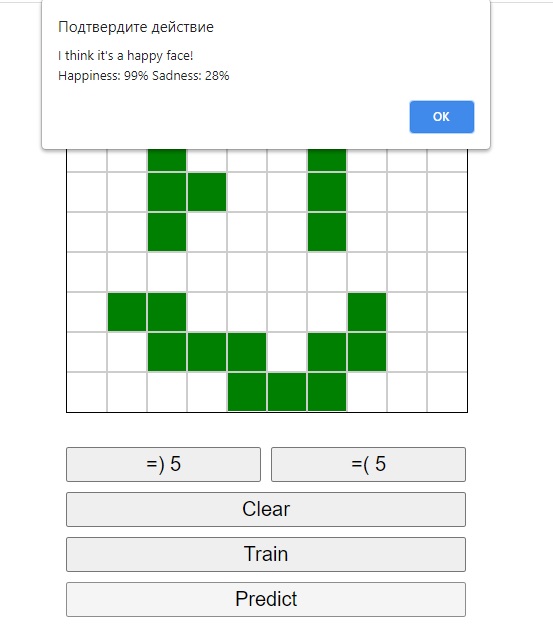で、物品の前の部分、我々はJSクラスの形で最も簡単なニューラルネットワークの実装を書きました。それでは、彼女に実際の割り当てを与えてみましょう。シナリオは次のようになります。ユーザーがWebページの特定のブロックにスマイリーを描き、ニューラルネットワークがそれが悲しいか面白いかを判断しようとします。始めましょう。
小さなアプリケーションをWebページとして実装しており、レイアウトとスタイル設定はトピックの範囲を超えているため、これらのポイントをスキップして、プログラミングについて詳しく説明します。まず、ページテンプレートを作成し、その上に要素を配置して、スクリプトをニューラルネットワーククラスに接続しましょう。
<!doctype html>
<html lang="en">
<head>
<meta charset="UTF-8">
<meta name="viewport"
content="width=device-width, user-scalable=no, initial-scale=1.0, maximum-scale=1.0, minimum-scale=1.0">
<meta http-equiv="X-UA-Compatible" content="ie=edge">
<script src="NeuralNetwork.js"></script>
<title>Sad Or Happy?</title>
</head>
<body>
<div id="wrapper">
<canvas width="400" height="400" id="paintField"></canvas>
<div id="controls">
<button class="control" id="happy"></button>
<button class="control" id="sad"></button>
<button class="control" id="clear">
Clear
</button>
<button class="control" id="train">
Train
</button>
<button class="control" disabled id="predict">
Predict
</button>
</div>
</div>
</body>
<style>
#wrapper {
width: 400px;
margin: 0 auto;
}
#paintField {
height: 400px;
width: 100%;
border: 1px solid black;
}
#controls {
display: grid;
grid-gap: 10px;
grid-template-columns: 1fr 1fr;
margin-top: 30px;
}
#clear, #train, #predict {
grid-column: 1 / -1;
}
.control {
font-size: 20px;
padding: 4px;
cursor: pointer;
}
</style>
<script>
</script>
</html>
コントロールを簡単に見てみましょう。
IDがpaintFieldのキャンバスは、それぞれ40ピクセルの10 x10のキャンバスです。その上で、ユーザーはマウスを使用してスマイリーを描き、ネットワークをトレーニングしたり、ネットワークから予測したりします。
idがhappyとsadのボタンは、ニューラルネットワークをトレーニングするためのデータセットを埋めます。ユーザーがスマイリーを描き、対応するボタンを押すと、ネットワークはそれを記憶し、少し賢くなりました。
Clear . , .
Train .
, , Predict . .
<script> .
const canvas = document.querySelector('#paintField');
const clearBtn = document.querySelector('#clear');
const sadBtn = document.querySelector('#sad');
const happyBtn = document.querySelector('#happy');
const trainBtn = document.querySelector('#train');
const predictBtn = document.querySelector('#predict');
const ctx = canvas.getContext('2d');
const paintField = new Array(100);
const trainData = [];
const NN = new Network(100, 2);
let mouseDown = false;
let happyCount = 0;
let sadCount = 0;
NN.learningRate = 0.8;
:
paintField - . 100 , .
trainData - .
NN - . 100 - paintField 2 . , , - .
, , learningRate .
.
function drawGrid() {
ctx.strokeStyle = '#CCC'
for (let i = 1; i < 10; i++) {
ctx.moveTo(0, i * 40);
ctx.lineTo(400, i * 40);
ctx.moveTo(i * 40, 0);
ctx.lineTo(i * 40, 400);
}
ctx.stroke();
}
function clearCanvas() {
ctx.fillStyle = '#FFF';
ctx.fillRect(0, 0, 400, 400);
drawGrid();
}
function drawSquare(row, column, color) {
ctx.fillStyle = color;
ctx.fillRect(column * 40 + 1, row * 40 + 1, 38, 38);
}
function draw(event) {
const rowIndex = Math.floor(event.offsetY / 40);
const columnIndex = Math.floor(event.offsetX / 40);
const arrayIndex = rowIndex * 10 + columnIndex;
paintField[arrayIndex] = 1;
const color = paintField[arrayIndex] ? 'green' : 'white';
drawSquare(rowIndex, columnIndex, color);
}
function clearField() {
paintField.fill(false);
clearCanvas(ctx)
}
function updateInterface() {
happyBtn.innerText = `=) ${happyCount}`;
sadBtn.innerText = `=( ${sadCount}`;
}
function storeResult(value) {
trainData.push([[...paintField], value]);
updateInterface()
}
drawGrid - .
clearCanvas - .
drawSquare - .
draw - , . , , .
clearField - .
updateInterface - , , .
storeResult - .
, , .
document.addEventListener('mousedown', (e) => {
mouseDown = true;
});
document.addEventListener('mouseup', (e) => {
mouseDown = false;
});
canvas.addEventListener('mousemove', (e) => {
if (!mouseDown) {
return;
}
draw(e);
});
clearBtn.addEventListener('click', () => {
clearField();
});
happyBtn.addEventListener('click', () => {
happyCount += 1;
storeResult([1, 0]);
clearField();
});
sadBtn.addEventListener('click', () => {
sadCount += 1;
storeResult([0, 1]);
clearField();
});
predictBtn.addEventListener('click', () => {
NN.input = [...paintField];
const [happiness, sadness] = NN.prediction;
alert(`I think it's a ${happiness > sadness ? 'happy' : 'sad'} face!\n
Happiness: ${Math.round(happiness * 100)}% Sadness: ${Math.round(sadness * 100)}%`);
});
trainBtn.addEventListener('click', () => {
NN.train(trainData, 1000).then(() => {
predictBtn.disabled = false;
alert('Trained!');
})
});
clearField();
updateInterface();
. . , , .
, - , - . , Train . ? ! Predict.

That’s all, Folks!
. , , . . .
.